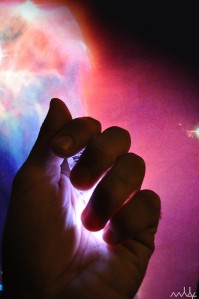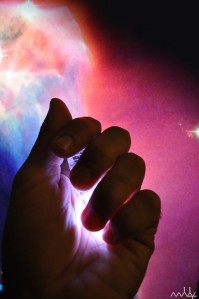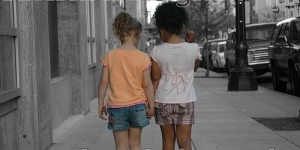
This magical image is by mariobraune and I found it on Flickr. Click the photo for more great images by this artist.
GONE by Michael Grant is totally set up to be a book about what kids would do if they had to build a society. Picture it: all of the adults disappear one day, suddenly, for no apparent reason. Simultaneously, a barrier made of God-knows-what-but-burns-to-the-touch encloses a large but limited area around the town. It’s a perfect set up for power struggles and warring factions. And GONE is that, but somehow it’s also much deeper.
It’s pretty cool how Mr. Grant managed the setting. There are two maps at the beginning of this book, one of the FAYZ (Fallout Alley Youth Zone, the area inside the barrier) and another of the town of Pardido Beach, California (the one small town within the barrier). Let me just say, I HATE books that include a map at the beginning. I usually think that means that the author doesn’t trust his writing enough to believe I can imagine his setting without pictures. Amusingly enough, after my initial grumble I completely forgot they were there. I didn’t need them, the setting was so clear.
It was fun to look at them after I finished the book, though, because despite the limit of the setting–it’s about 62 square miles enclosed under the dome–the setting is wildly diverse. I honestly don’t think that this book could have been set anywhere other than California. The FAYZ contains a beach (which plays a pivotal role in a chase scene), the desert (which plays a pivotal role in one character’s survival story), hills and forests (which offer a nice variety of wild-life to mutate and become terrifying), a gold mine, and some barrier islands. As far as structures go, there’s one town, a nuclear power plant, a private school, and a marina. Everything a pack of unsupervised children need.
However, the real treasures of this book are the characters. Things don’t break down as utterly black and white. Sure, we have our “good” characters: Sam, the protagonist; Astrid, his brilliant girlfriend; Edilio, the kid who’s got your back. On the other side of the equation, we have the “bad” characters: Caine, the leader of the private school kids; Diana, his sort-of love interest; and especially Drake, the private school psychopath that likes to hurt people.
However, the bulk of the characters are the variety that is working each day to do their best. Some of them are weak and some of them are clueless but all of them are complex.
- There’s Mary, who later becomes known as “Mother Mary” who takes care of all of the little children. She’s super-stressed, battling an eating disorder, and experimenting with self-medication.
- There are the two local bullies: Orc and Howard. Orc is the brawn and Howard is the brains. While they’re annoying and potentially dangerous, they’re nothing compared to the evil that is Caine.
- There’s little Pete, Astrid’s autistic younger brother. Who knows if he’s good, bad, or neutral? He joins my ranks of spooky little kids, though.
- One of the most conflicted characters is Quinn, Sam’s best friend. He longs to be special and wants to lead but lacks the courage. He goes with the flow, even if the flow is being directed by some pretty dastardly dudes.
- Or, my personal favorite, Lana and her dog Patrick, who find themselves stranded out in the desert when Lana’s grandfather blinks out as he’s driving them home. She is On. Her. Own. Stuck in a mining shack, surrounded by mutated coyotes.
I could go on and on. These characters, the ones doing their best, were the best part of this book for me. The idea that there would be a “good” side and a “bad” side was conventional. The concept of a power struggle was utterly predictable. But the idea that there might be kids filling roles with utter reluctance, in over their heads and coping badly was just simply beautiful.
Throw in the super powers and you’ve got one big mess!
So that’s the characters and the setting. On Monday, I’ll tackle the plotting. This was a pretty long book and Mr. Grant kept the pacing good and fast. I’ll see if I can’t figure out how this author does it!









